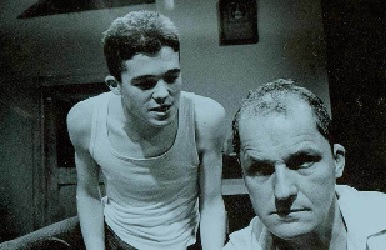
One of the most popular plays ever staged in the west of Ireland was The Country Boy by John Murphy from 1959, chiefly by Charlestown Theatre Group and produced by a doyen in local amateur dramatic circles, Paddy Henry. The play had many resonances which were familiar in the west of Ireland at the time. Located near Castlebar in County Mayo in the late fifties, The Country Boy is based on the theme of emigration and its effects on those who went and on those who stayed, with the dreams, thoughts and fears as seen from both sides of the Atlantic over two generations. The plot centres around the family of Tom Maher and his wife, Mary Kate, who farm a small holding. They have two sons, Eddie and Curly. Eddie has just arrived back from the USA after fifteen years, with his American-born wife, Julia, and is hailed as a paragon of success. Curly, 25, now wants to follow Eddie to America, chiefly to escape from the stultifying influence of his obdurate, dominating, and uncommunicative father. After a short time, the initial boasting of their success by Eddie and Julia gives away to exchanges which show a troubled marriage and that their real lifestyle, of hardship, alcoholism, and numerous regrets, is far from what they led their family in Ireland to believe. As a result, Eddie does not want Curly to follow in his footsteps and tries to convince him that he would be far better off to remain at home. Curly has a girlfriend, Eileen Tierney, and is torn between his love of her and his desire to escape to a new life. Tom Maher, a product of his time, place, and circumstances, has inevitably to accept change. It results in a happy ending, but with a final revealing comment from the aging patriarch. Eventually Curly and Eileen agree to marry and stay at home. He informs his parents of the news and that the wedding will take place on Monday… three weeks. His father, Tom, responds:
“Monday, three weeks (slowly something dawns on him and he turns back into the kitchen, his face a mixture of pain and frustration), well wouldn’t you swear he does it to me on purpose. Monday, three weeks! The bloody fair-day in Castlebar!”
John Murphy (1924-1998) was born in Bellaghy, Charlestown, County Mayo. As a youth, he was a member of the Charlestown Dramatic Society. Like so many young men and women of his generation he was forced to leave and seek employment in England. After some time in England, he went to Belfast, working as a ship engineer for a company based in Rugby. There, he regularly attended plays staged by the Ulster Group Theatre. He wrote The Country Boy in Belfast in 1958. Its first production was by the Ulster Group Theatre in Belfast on April 7, 1959, followed by a month later by the Abbey Theatre in Dublin on May 11. It proved to be a great success. After attempting to secure employment in RTÉ, John Murphy became disillusioned with Ireland and, after marrying Kathleen Rodgers from Sonnagh, Charlestown, they left the country, settling for a few years in England before emigrating to Los Angeles. He worked as a lighting technician and engineer in Hollywood for Disney, Paramount and 20th Century Fox. He started another play, “The Man from Ballybeg”, but it was not published or produced. John Murphy came to Charlestown in September 1996 to see the local Dramatic Society unveil a plaque on the house in Bellaghy where he was born. (Thanks to Paddy Henry, I had the pleasure of meeting him on that occasion). John Murphy died in Los Angeles on May 31, 1998, and his ashes were buried on the side of Nephin Mountain in County Mayo at his request.

